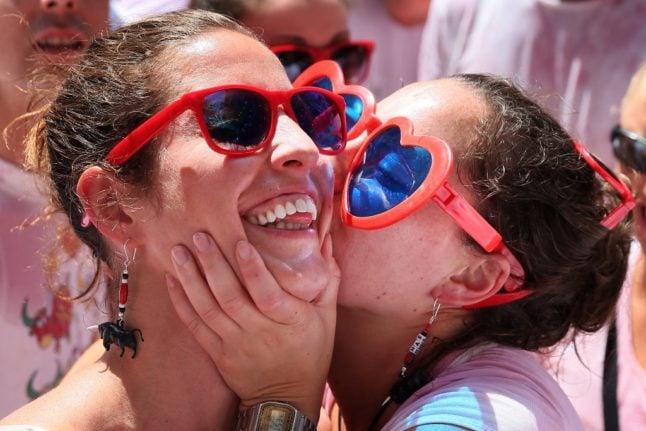Getting the kisses wrong
As a result of the pandemic, this quintessential Spanish habit was was put hold for a time, but now it’s back in most social settings.
Kissing on the cheeks isn’t all that common around the world, meaning that foreigners in Spain sometimes get this traditional greeting wrong, which can lead to some awkward situations.
Most of the time, when a man and woman, or a woman and another woman, meet or are introduced to each other in a social setting, they give each other two kisses. If it’s two men then they shake hands or hug depending on how close they are.
It’s two kisses on the cheek, starting on the left side (as in your head goes to the left and your right cheek presses against theirs) . This can be particularly confusing for kiss-giving nationals like the French who start on the right.
It doesn’t necessarily have to involve lip-cheek contact either, often it’s rather cheek to cheek, lightly brushing against each other.

And yes, there are certain cases where people only give one kiss, which can lead to some slightly awkward head bobbing as you head in for the second beso. Unfortunately, there isn’t really a regional rule to warn you of this.
In business settings, handshakes are becoming increasingly common in Spain but there are still instances where los dos besos (the two kisses) were the official greeting.
There is nothing wrong with not abiding by Spain’s kiss greeting rules but a Spanish person may be slightly offended if you pull back and avoid their kisses in a social setting (known colloquially as hacer una cobra, doing a cobra).
READ ALSO: What are Spain’s rules on kissing?
When you greet someone without stopping
It may seem weird to English speakers, but if you pass someone you know in the street but don’t actually stop to talk to them, the normal thing to say is ‘bye’ or ‘see you later’ rather than ‘hi’ or ‘hello’.
So rather than saying hola or buenos dias/tardes, the more normal way of greeting someone on the go in Spain is by saying adiós or hasta luego.
This is starting to remind us a bit of a certain song by The Beatles.
Lunging in for a hug too soon
Some foreigners might assume kissing on the cheeks is higher up in the (wait for it) pecking order, and therefore think that hugs are a step down from this.
The reality of it is that hugs – abrazos in Spanish – are generally not given when you’ve just met someone (unless you hit it off straight away, and quite possibly when there’s alcohol involved).
Spaniards are definitely more touchy-feely than the average nation but if there isn’t a friendship established yet, hugging someone might catch them a bit by surprise.
It’s a far safer bet to opt for the two kisses or handshake early on.

Bono from U2 enjoys a hug with Penélope Cruz. Photo: ANDER GILLENEA / AFP
Mixing up buenos días and buenas tardes
Saying good afternoon exactly after midday -12 o’ clock – isn’t something that all Spaniards do.
Technically, you should be saying buenas tardes when the clock strikes 12 but if you say buenos días at 1pm you won’t necessarily get any weird looks from Spaniards. You may do however if you say buenos días well into the afternoon at 5 or 6pm.
What’s the easiest way around it? Just say buenas, a perfectly acceptable and formal greeting which can be used to say hello to someone at any time of the day. And yes, hola also works.
Forgetting there isn’t a way to say good evening in Spanish
It’s 7pm in Spain, you go into your local supermarket and the cashier says buenas tardes. It’s 8pm in Spain, and the barman at your local bars greets you with buenas tardes once again. When do the afternoons actually end in this country?
Technically you can use buenas tardes until it gets dark; the time concept of evening isn’t one that’s defined in the Spanish dictionary or in popular use.
In this sense the best way to say ‘good evening’ if it’s nighttime is buenas noches – good night – although most Spaniards only use it to say goodbye at night when it’s time to call it a day. Again, the easiest way around it is to use buenas or hola.
READ ALSO – Wet the doughnut: Ten hilarious Spanish expressions to refer to sex



 Please whitelist us to continue reading.
Please whitelist us to continue reading.
Member comments